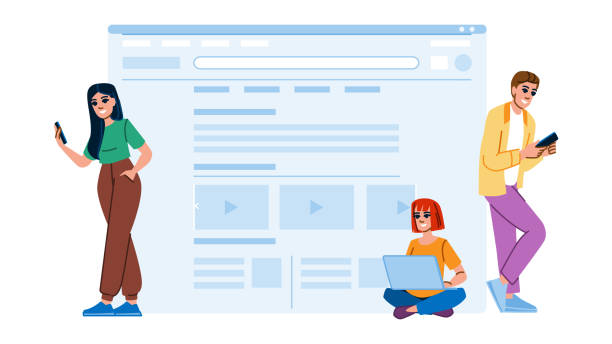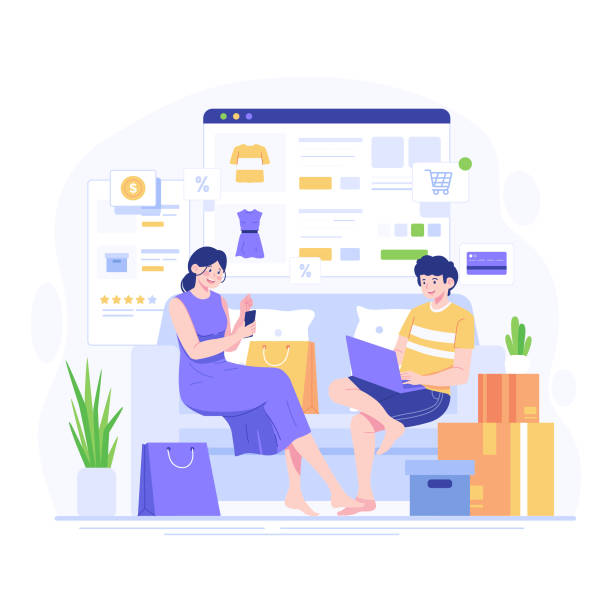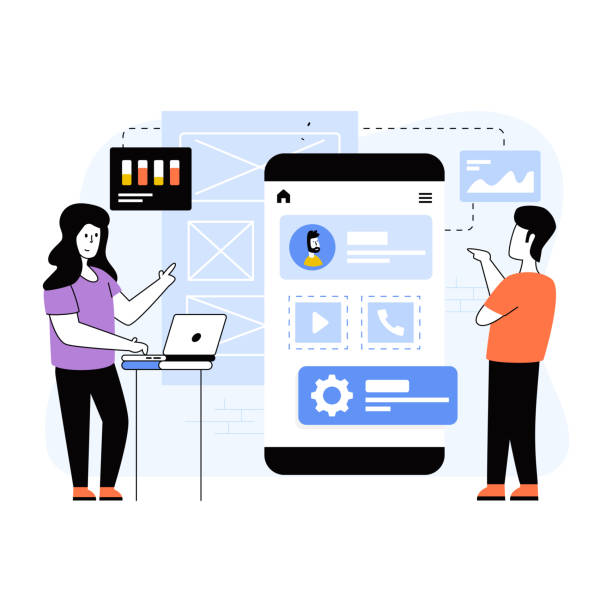Introduction to the World of E-commerce and the Importance of Online Store Design
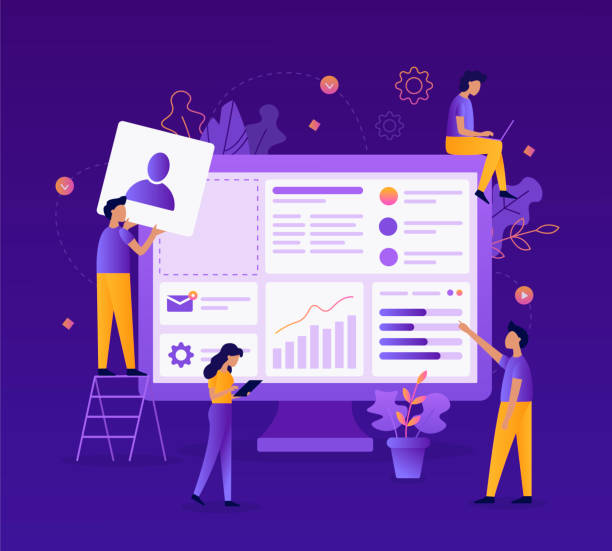
In the current era, where technology has removed borders and access to information is possible in a fraction of a second, #e_commerce has become the backbone of the #modern_economy.
It is no longer enough to just have a physical store in a specific location; a powerful and active online presence is vital for every business, from the smallest startups to the largest international companies.
This is where the importance of online store design becomes more evident than ever.
An online store not only allows you to offer your products and services globally without geographical limitations, but also provides customers 24/7 access to your business.
This endless access means unlimited sales opportunities and a significant increase in revenue, even when you are resting.
In addition to direct sales, an e-commerce website is a powerful place to build and strengthen your brand, directly interact with customers, and gather valuable feedback that can help continuously improve your products, services, and business strategies.
Professional online store design goes beyond a digital storefront; it’s a comprehensive platform for creating a unique and memorable shopping experience for your customers.
This experience includes easy and intuitive site navigation, comprehensive and accurate product information, high-quality images, and a secure and fast payment process.
The ultimate goal is for the customer to feel comfortable and confident without any obstacles, from the moment they enter until the completion of their purchase.
Ultimately, investing in developing an online sales platform is not just an additional cost, but a strategic and long-term investment to ensure the future and sustainability of your business in the digital world.
Therefore, a correct understanding of the needs and precise planning for launching an online store is the first and most important step to achieving sustainable success in today’s highly competitive environment.
This introduction serves as an educational and explanatory content to help you understand the vital importance of this topic and proceed to the next steps with a broader perspective.
With the ever-increasing advancement of technology and the shift in consumer buying habits towards #online_shopping and ease of access, businesses that fall behind in the wave of digitalization will have a much lower chance of survival and growth in the market.
Disappointed with your online store’s low conversion rate? Rasaweb transforms your online store into a powerful tool for attracting and converting customers!
✅ Significant increase in visitor-to-buyer conversion rate
✅ Unparalleled user experience to boost customer satisfaction and loyalty⚡ Get a free consultation from Rasaweb!
Initial Planning Stages for Designing a Successful Online Store
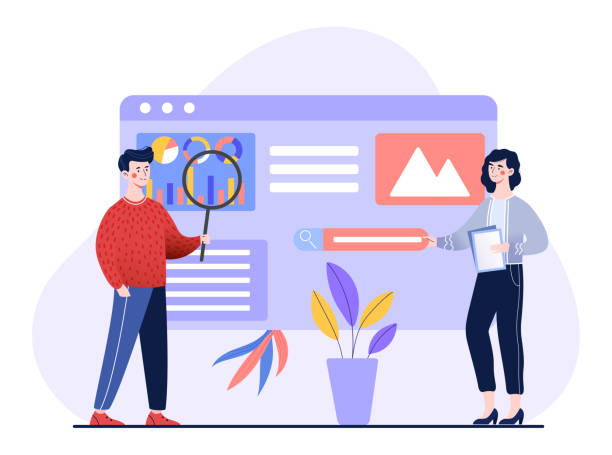
Before any action for #online_store_design, the #strategic and precise #planning stage is of particular importance.
This stage, which has a #guidance and #expert nature, forms the foundation for your long-term success.
First, you need to accurately define your product or service and identify your #market_niche.
Is your target market young people or the elderly? Are your products luxurious or economical? Are your services specific to a particular industry or general? Answering these questions helps you tailor your marketing strategy, visual site design, and even your customer communication approach.
After that, you need to conduct thorough market research.
Identify your direct and indirect competitors and carefully analyze their strengths and weaknesses.
What made them successful, and what opportunities for improvement or innovation have they missed? This competitive analysis gives you a comprehensive view to create your unique competitive advantage and differentiate yourself in the market.
Also, setting clear, measurable, achievable, relevant, and time-bound (SMART) goals for your online store is crucial.
Is your goal merely to increase sales, or to expand brand awareness, reduce operational costs through automation, or increase customer loyalty? Each of these goals requires a different approach in e-commerce store design and digital marketing.
Budgeting is also an important planning stage.
You need to determine how much you can spend on online store development, initial and ongoing marketing costs, and long-term maintenance.
This helps you prevent resource waste and make smarter financial decisions that lead to a desirable return on investment.
Finally, write a detailed operational plan that includes a timeline, specific tasks, and responsibilities for each section.
These initial steps help you build an online store that is not only technically powerful but also aligned with your overall business goals and has high potential for long-term growth and profitability.
Success in e-commerce website design is rooted in sound planning and foresight.
Choosing the Right Platform for Your Online Store Design

Choosing the right #e_commerce_platform is the next crucial step in the #online_store_design process that profoundly impacts the efficiency, scalability, and future success of your online business.
This stage requires an #analytical and #educational approach.
Platforms are generally divided into two main categories: Open-Source solutions and Cloud-based solutions (SaaS – Software as a Service).
WooCommerce (WooCommerce) which is built as a powerful plugin on the popular WordPress content management system, is a popular open-source option that offers high flexibility in customization and development, suitable for a wide range of small and medium-sized businesses.
However, its use requires more technical knowledge for hosting management, installation, updates, and troubleshooting.
In contrast, Shopify (Shopify) is a SaaS platform that provides ease of use, strong support, high security, and cloud hosting all in one place.
This platform is ideal for those looking for a quick and hassle-free setup, but you have less control over your code and server, and it may incur higher monthly fees and transaction charges in the long run.
Magento (Magento) is another powerful open-source option that is suitable for larger companies with complex needs, high product volumes, and high traffic, but it requires very high technical expertise for installation, configuration, development, and maintenance, and its operational costs are significantly higher.
The platform choice should be based on factors such as available budget, the technical knowledge of your team, future scalability needs, specific and unique features you require for your online store, and your long-term business goals.
For example, if you are looking for a quick and hassle-free solution with minimal technical knowledge required, Shopify is a better option.
However, if full control over the code, unlimited customization capabilities, and deep integration with your internal systems are desired, WooCommerce or even a custom online store design can be more suitable.
Below, a comparison table is provided to help you make a more precise decision.
This choice will be the beating heart of your online store and a mistake in it can bring many challenges.
Therefore, carefully and meticulously review the available options and, if necessary, seek assistance from expert consultants in this field to build the best foundation for your e-commerce business.
| Feature | WooCommerce | Shopify | Magento |
|---|---|---|---|
| Platform Type | Open-Source (requires independent hosting) | Cloud (SaaS) | Open-Source (more complex, powerful hosting) |
| Ease of Use | Medium (with WordPress and plugin knowledge) | High (suitable for beginners and non-technical users) | Low (requires deep technical expertise) |
| Initial/Monthly Cost | Low (only hosting, theme, and some plugins) | Medium (monthly plans and transaction fees) | High (initial development, maintenance, expertise) |
| Scalability | Medium to High (with suitable hosting) | High (suitable for rapid growth) | Very High (suitable for large organizations) |
| Customization Capabilities | Very High (with code access) | Medium to High (with platform limitations) | Very High (complex but powerful) |
| Support | Large user community, developers, and plugins | Excellent (24/7 direct platform support) | Specialized and costly (through developers) |
UI/UX Design in Online Store
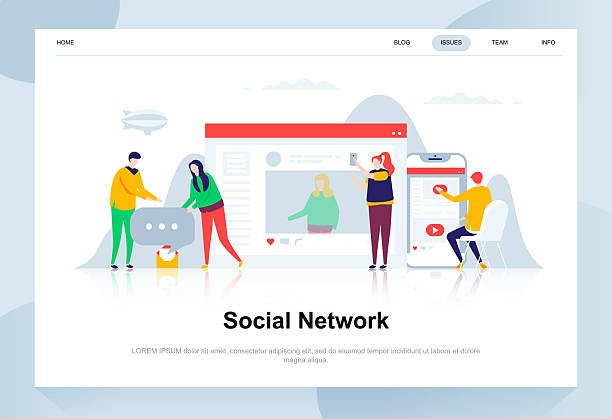
After choosing the right platform, it’s time for one of the most crucial aspects of #online_store_design: #User_Interface (UI) and #User_Experience (UX) design.
This section, which has an #expert and #guidance nature, directly impacts customer satisfaction, the duration of their stay on the site, and consequently, your site’s conversion rate.
A strong UI/UX design means creating a smooth, intuitive, and enjoyable path for customers, from the moment they enter the site until the completion of the purchase process.
This includes ensuring #Responsive_Design, meaning your site should display correctly on every device, from mobile phones and tablets to laptops and desktops, with optimized layout and providing a consistent user experience.
Given the increasing number of mobile users, mobile-first design is of utmost importance.
Site navigation should be simple, logical, and predictable, allowing customers to easily find their desired products and move from one category to another.
Using clear and concise menus, distinct product categories, and a powerful search bar with keyword suggestion capabilities are among the requirements of this section.
Product pages should also include strong visual elements such as high-quality images and videos from various angles, complete and engaging product descriptions, pricing information, availability, color and size options, and clear and prominent Call-to-Action (CTA) buttons.
Do not underestimate the importance of writing user-friendly and persuasive content in these pages; the content should be both informative and persuasive.
The payment process should also be as simple, fast, and frictionless as possible; any additional step or complexity can lead to shopping cart abandonment and lost sales.
Providing diverse payment options and ensuring the security of customers’ financial information are other key points in this stage.
UX Design actually covers all aspects of user interaction with your business, not just the website.
Therefore, throughout the e-commerce store design, always put yourself in the customer’s shoes and think about what makes their shopping experience more enjoyable, easier, and more reliable.
An online store with an excellent user experience not only increases your sales but also significantly helps build customer loyalty.
Are you frustrated with your online store’s low conversion rate?
Rasaweb, with professional online store design, is your definitive solution!
✅ Increase your sales and revenue
✅ Unparalleled user experience for your customers
⚡ Get a free consultation now!
SEO and Content Marketing for Increased Visibility of Your Online Store
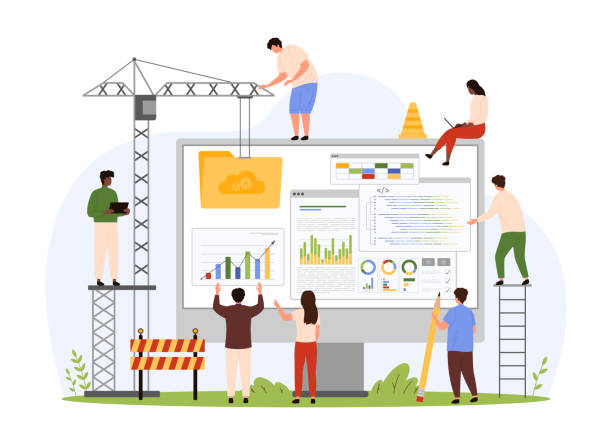
Having a beautiful and user-friendly #online_store is practically useless without being seen by potential customers.
This is where the role of #SEO (Search Engine Optimization) and #content_marketing in the #online_store_design process becomes prominent.
This section has an #educational and #expert nature and helps you sustainably increase your site’s organic and targeted traffic.
SEO includes a set of techniques and strategies that help search engines like Google better understand your website’s content, deem it relevant, and rank it higher in search results.
This includes On-Page SEO such as comprehensive keyword research, optimizing page titles, meta descriptions, heading tags, and URL structure, as well as Off-Page SEO such as building quality links (backlinks) from reputable sites and effective activity on social networks.
For an online store, choosing keywords related to products and categories, and also long-tail keywords that target specific customer needs, is crucial.
Make sure your product descriptions, category descriptions, and blog content naturally and without overuse include target keywords, and simultaneously be attractive, informative, and persuasive for users.
Content marketing is also an inseparable part of this strategy.
Creating valuable, relevant, and engaging content, such as educational blog articles, comprehensive buying guides, product reviews, instructional videos, and infographics, not only helps your site’s SEO but also builds customer trust and introduces you as a credible authority in your industry.
For instance, if your online store sells home appliances, you can write articles about “Guide to choosing the best side-by-side refrigerator for your family” or “How to maintain your washing machine to increase its lifespan.”
This approach not only attracts targeted and high-quality traffic but also significantly helps increase conversion rates, as users are guided towards purchase with more awareness and trust.
Remember that SEO is a continuous and long-term process, and its results appear over time, so be patient and constantly update and optimize your content to remain sustainable in search results.
Payment Security and Banking Gateways in Online Store Design
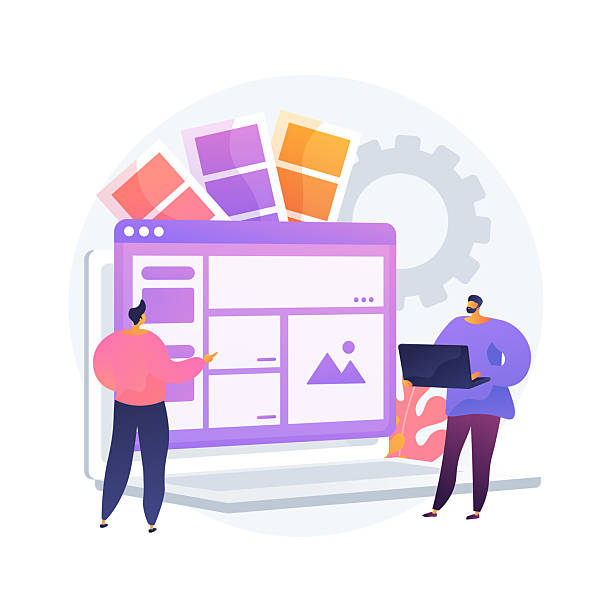
One of the most significant concerns for customers when #online_shopping is the security of their financial and personal information.
Therefore, ensuring #payment_security and selecting a suitable #banking_gateway is a critical and indispensable aspect of #online_store_design.
This section has an #explanatory and #expert nature and helps you gain and maintain your customers’ trust.
The first and most important step is to use a valid SSL (Secure Sockets Layer) certificate.
SSL encrypts information between the user and the server, preventing any eavesdropping and unauthorized access to sensitive information such as bank card numbers, passwords, and personal details.
The presence of a green lock icon next to the site address in the browser and the address starting with https instead of http, indicates the use of SSL and visually instills a sense of trust and security in customers.
Choosing a secure and reputable payment gateway is also very important.
In Iran, direct bank payment gateways or reputable intermediary companies like Zarinpal, IDPay, or Asan Pardakht are common options.
Ensure that your chosen gateway has the necessary international security standards (such as PCI DSS) and makes the payment process as simple, smooth, and hassle-free as possible for the user.
Any complexity or lack of transparency at this stage can lead to shopping cart abandonment.
Furthermore, you must clearly state your user privacy policies on your site.
Collecting the minimum necessary information from customers and providing full transparency on how this information is used and stored greatly gains their trust.
Preventing various cyber attacks such as phishing, DDoS attacks, and SQL injection is also among your responsibilities.
Using strong firewalls (WAF), regularly updating systems, plugins, and site themes, conducting periodic penetration tests, and educating staff on security issues are very important preventive measures.
A secure online payment system not only protects your and your customers’ financial and personal information but also significantly contributes to the credibility and reputation of your online store.
Nothing can destroy customer trust and cause irreparable damage to your online business as quickly as a serious security issue.
Inventory Management, Shipping, and Customer Support in an Online Store
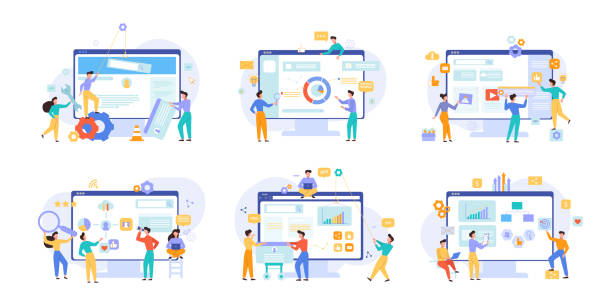
After customers have found their desired product in your #online_store and successfully completed the payment process, it’s time for after-sales processes, which are equally important and vital.
This section has a #guidance and #analytical nature and helps you manage your #online_store_operations in the best possible way and maintain customer satisfaction at the highest level.
Efficient and accurate #inventory_management is the first step to prevent over-selling (which leads to customer dissatisfaction) or over-stocking (which ties up capital).
The use of Inventory Management Systems (IMS) that automatically update with every sale, return, or new shipment arrival is essential.
These systems can seamlessly integrate with your online store design platform.
In the shipping section, providing various and flexible options to customers, including standard shipping, express shipping for faster delivery, and even the possibility of in-person pickup from the store or warehouse if your business has this capability, is very important.
Full transparency in shipping costs and providing accurate estimated delivery times are of high importance.
Order Tracking capability is also a feature that today’s customers expect and provides them peace of mind, as they can check the status of their purchased item at any time.
Finally, strong and responsive customer support is the backbone of retaining existing customers and building long-term loyalty.
Provide multiple and accessible communication channels such as phone, email, instant online chat, and social media, and respond to customer questions, complaints, and problems quickly, respectfully, and efficiently.
A quick response and effective problem resolution can turn a negative experience into a golden opportunity to strengthen customer relationships.
The Frequently Asked Questions (FAQ) section on your online store can cover many common questions and significantly reduce the workload of the support team.
These three areas, if properly planned and managed, not only lead to customer satisfaction but also help increase the credibility and reputation of your online business and pave the way for sustainable growth.
| Operational Area | Key Actions | Suggested Tools |
|---|---|---|
| Inventory Management | Automatic inventory updates, low stock alerts, physical and software inventory, SKU system | WooCommerce inventory management plugins, Shopify modules, ERP/CRM software, barcode system |
| Shipping | Offer diverse shipping options (standard, express), cost transparency, real-time order tracking | National postal services (e.g., Islamic Republic of Iran Post), private courier companies (e.g., Tipax, Allopeyk), platform shipping plugins, logistics management software |
| Customer Support | Multiple communication channels (phone, email, chat), fast and professional response, comprehensive and searchable FAQ section | Ticketing systems (e.g., Zendesk), online chat (Live Chat), CRM software (e.g., Salesforce), smart chatbots |
| Returns and Exchanges | Transparent and fair return policy, easy and user-friendly process for customers, fast refunds | Platform return modules, online forms, direct communication with support team |
Upgrading and Maintaining the Online Store After Launch
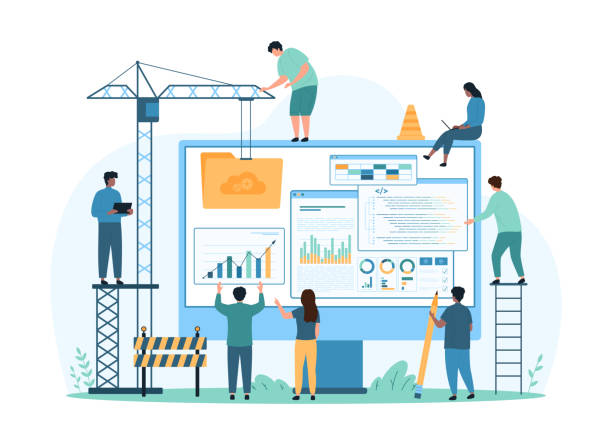
Successfully launching an #online_store is just the beginning, not the end.
To maintain optimal performance, high security, and competitiveness in the rapidly changing digital market, #continuous_upgrades_and_maintenance are essential and vital.
This section of the article, which has an #expert and #news (regarding updates and new trends) nature, shows you how to keep your e-commerce store live, dynamic, secure, and up-to-date with the latest technologies after its design.
One of the most important aspects of maintenance is regular updates to the main platform software (such as WordPress and WooCommerce, or new versions of Shopify) and all used plugins, themes, and modules.
These updates not only add new features and improve site performance but, more importantly, also fix identified security vulnerabilities.
Neglecting these updates can leave your site vulnerable to cyber attacks, data loss, or severe performance degradation.
Monitoring site performance is also crucial.
Powerful analytical tools like Google Analytics and Google Search Console help you comprehensively monitor page load speed, conversion rates, user behavior, traffic sources, best-selling products, and potential errors.
If your site speed is low, not only will the user experience suffer and customers leave the site, but your SEO ranking in search engines will also decrease.
Optimizing site speed through image compression, using CDN (Content Delivery Network), caching, and code optimization, is of high importance.
Also, you should regularly and systematically back up all your site files and database so that in case of any serious problem (such as a cyber attack or human error), you can quickly and without losing data, restore it.
A/B testing is also an excellent way to optimize conversion rates and continuously improve the user experience.
By testing different elements such as titles, product images, Call-to-Action (CTA) buttons, and page layouts, you can identify the best options and increase your sales and profitability.
The world of e-commerce is constantly changing, and keeping up with new trends, such as personalizing the shopping experience, or adding new features to your online store (e.g., smart chatbots, augmented reality), is essential to maintain a competitive advantage and stay at the forefront of the market.
Is your company’s website performing as it should for your brand? In today’s competitive world, your website is your most important online tool. Rasaweb, a specialist in professional corporate website design, helps you to:
✅ Build credibility and customer trust
✅ Convert website visitors into customers
⚡ Get a free consultation now!
Data Analysis and Success Metrics in Online Store Design
![]()
After launching and maintaining an #online_store, the next step to ensure continuous growth and improvement is #data_analysis and monitoring #success_metrics (KPIs).
This section, which has an #analytical and #thought-provoking nature, helps you objectively and accurately measure the performance of your online store design and make data-driven decisions that lead to real business growth.
Powerful tools like Google Analytics provide invaluable information about user behavior, incoming traffic sources, best-selling products, shopping cart abandonment rates, and potential weaknesses of your site.
But the question is: how do we interpret this vast amount of data and use it for real and strategic business improvement? The most important metrics to continuously monitor include the #conversion_rate; that is, the percentage of visitors who perform your desired actions (such as purchasing, signing up, or adding to cart).
If your conversion rate is low, you should look into improving the user experience (UX), optimizing product pages, or refining the payment process.
Average Order Value (AOV), Cart Abandonment Rate, and Return on Investment (ROI) from various marketing activities, are other crucial metrics that indicate the effectiveness of your strategies.
Additionally, User Journey Analysis can show you where users encounter problems or abandon the site during the purchase process.
Are they unexpectedly leaving a specific page? Are your call-to-action buttons not clearly visible and engaging? These types of questions and careful data analysis lead to continuous and targeted improvements.
Web analytics also helps you understand which marketing channels (such as SEO, social media, paid advertising, email marketing) bring the most qualified traffic and the best conversion rates to your online store.
By properly and intelligently using this data, you can refine your strategies, optimize your marketing budget, and run more effective campaigns.
Ultimately, with this analytical approach, you can achieve a more efficient and profitable online store design that is continuously growing and improving.
This data gives you the power to predict and make strategic decisions for future growth and sustainability in the competitive market.
Challenges and Opportunities Ahead in the World of Online Store Design

The world of #online_store_design is constantly evolving, and every day it faces new challenges and opportunities, which are vital for any online business owner to understand.
This section, which has an #entertaining and #thought-provoking nature, explores future trends and new horizons in e-commerce and invites you to reflect on the future of this industry.
One of the biggest opportunities is the use of #Artificial_Intelligence (AI) and #Machine_Learning (ML) for #personalizing_the_shopping_experience.
Imagine a website that knows exactly what the customer wants, even before they do! Smart recommendation systems that suggest relevant products based on user purchase and search history, advanced AI-powered chatbots for 24/7 customer support, and predictive analysis of buying behavior can all significantly contribute to increasing sales, improving user experience, and building customer loyalty.
But the challenge is: how do we effectively and cost-efficiently implement these advanced technologies without creating unnecessary complexity in the online store? Another challenge is the increasing competition in the online market.
With millions of online stores worldwide, how can you make your brand’s voice heard and surpass tough competitors? The answer lies in offering a Unique Selling Proposition, creating an unparalleled and beyond-expectation user experience, and establishing deep and meaningful connections with customers.
Emerging trends such as #Social_Commerce, which allows direct purchasing from social platforms like Instagram or TikTok, and Augmented Reality (AR) and Virtual Reality (VR) for displaying products in 3D and interactive experiences, create new opportunities for customer interaction and increasing conversion rates.
Are customers ready to walk through your store with VR glasses and see products up close in their homes? Additionally, sustainability, ethics, and social responsibility in the supply_chain have become increasing concerns for the new generation of consumers, and online stores that address these issues and maintain transparency can gain a significant competitive advantage.
The future of online store design depends on innovation, rapid adaptability to changes, and a constant focus on evolving customer needs, not merely new technologies.
Frequently Asked Questions
| Question | Answer |
|---|---|
| 1. What is online store design? | The process of building an online platform where products or services are displayed for sale to customers. |
| 2. Why should we have an online store? | 24/7 access to customers, reduced costs, market expansion, and increased sales without geographical limitations. |
| 3. What are the most important features of a successful online store? | User-friendly interface, high loading speed, security, diverse online payment options, and advanced search and filter capabilities. |
| 4. What does it mean for an online store to be responsive? | It means that the site displays correctly and with an appropriate layout on all devices (mobile, tablet, desktop). |
| 5. What role does SEO play in the success of an online store? | It increases the site’s visibility in search engine results and attracts more organic (free) traffic to the store. |
| 6. Which platforms are popular for building an online store? | WooCommerce (for WordPress), Shopify, Magento, and PrestaShop are among the widely used platforms. |
| 7. How important is security in an online store? | It is of very high importance because sensitive customer information (such as bank card details) and personal data are exchanged. Using SSL is essential. |
| 8. What is an online payment gateway and why is it necessary? | It is a system that allows online payment collection from customers. It is essential for financial transactions in an online store. |
| 9. What steps should be taken after launching an online store? | Digital marketing (SEO, social media), product updates, customer support, and visitor data analysis. |
| 10. Is programming knowledge required to design an online store? | It depends on the chosen method. With CMS like WordPress and WooCommerce, a store can be launched without programming knowledge, but it is needed for advanced customization. |
And other services of Rasaweb Advertising Agency in the field of advertising:
Smart Social Media: An effective tool for online growth with precise audience targeting.
Smart Website Development: A combination of creativity and technology for campaign management through SEO-driven content strategy.
Smart Marketplace: A dedicated service for growth in sales increase based on marketing automation.
Smart Advertorial: An effective tool for campaign management through SEO-driven content strategy.
Smart SEO: Revolutionize click-through rates with attractive UI design.
And over hundreds of other services in internet advertising, advertising consultation, and organizational solutions.
Internet Advertising | Advertising Strategy | Advertorial
Sources
Step-by-Step Guide to Online Store Design
Advantages of Professional Online Store Design
Important SEO Tips in Online Store Design
Choosing the Best Platform for Building an Online Store
? Are you ready to transform your business in the digital world? Rasaweb Afarin Digital Marketing Agency paves your path to online success by providing innovative solutions including responsive website design and professional optimization. To be seen, grow, and increase customers, contact us today.
📍 Tehran, Mirdamad Street, next to Bank Markazi, Southern Kazeroon Alley, Ramin Alley, No. 6

